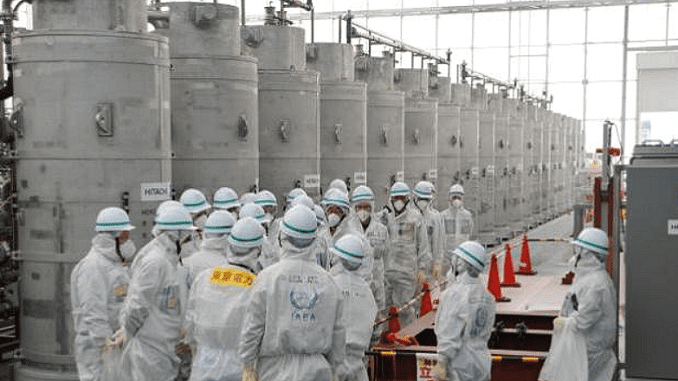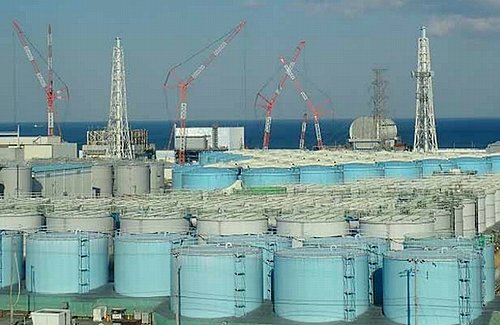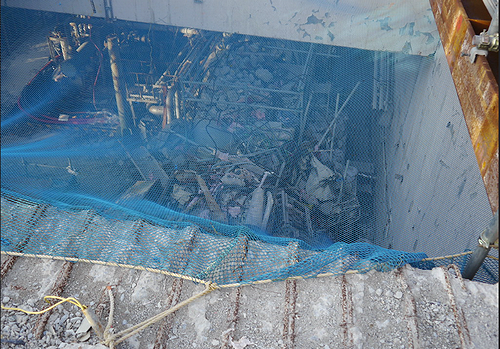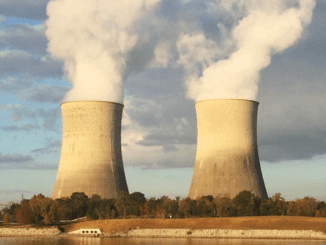
TOKYO, Japan, July 24, 2022 (ENS) – Japan’s nuclear regulator on Friday officially approved a plan to release more than a million tons of treated water from the damaged Fukushima Daiichi nuclear power plant in northeast Japan into the ocean.
Already, the plan has been adopted by the government and endorsed by the International Atomic Energy Agency, IAEA, but plant operator Tokyo Electric Power Company, TEPCO, must still persuade local communities that it’s a good idea before going ahead.
Japan’s Nuclear Regulation Authority has approved TEPCO’s plan, according to a foreign ministry statement, which said the government would ensure the safety of the treated water as well as the “reliability and transparency of its handling.”
Cooling systems at the Fukushima nuclear plant were overwhelmed on March 11, 2011 when a tsunami triggered by a massive undersea quake caused the worst nuclear accident since the fire at Chernobyl in 1986.
Decommissioning work underway now at Fukushima is expected to take around 40 years, with efforts to remove molten fuel from damaged reactors among the tasks ahead.
Each day, the site produces 140 cubic meters of water contaminated with nuclear radiation – a combination of groundwater, seawater and rainwater that seeps into the area, and water used for cooling.
The water is filtered to remove various radionuclides and moved to storage tanks, with 1.29 million tons on site already and space expected to run out about a year from now.
TEPCO says the treated water meets national standards for radionuclide levels, except for one element, tritium, which experts say is only harmful to humans in large doses.

The nuclear regulator’s approval document promises that the “treated water will then be sufficiently diluted before the discharges so that all radioactive materials including tritium will be far below the regulatory standards for safety.”
It plans to allow release of the treated wastewater offshore over several decades via a kilometer-long underwater pipe.
The IAEA says the release, which will take place over many years and is not expected to begin before spring 2023, meets international standards and “will not cause any harm to the environment.”
But local fishing communities who could not sell their fish after the nuclear accident fear consumers will once again avoid their products if the treated Fukushima water is released in the area.
There has also been criticism from regional neighbors including South Korea and China, as well as environmental groups like Greenpeace.
Four TEPCO Executives Penalized 13 Trillion Yen
Earlier this month in a lawsuit brought by TEPCO shareholders back in 2012, a Tokyo court ordered four former TEPCO heads to pay a total of 13.32 trillion yen (US$97 billion) for the damages caused by the Fukushima nuclear power plant meltdown.
In a lawsuit brought by TEPCO shareholders back in 2012, a Tokyo court earlier this month ordered four former TEPCO heads to pay a total of 13.32 trillion yen (US$97 billion) for the damages caused by the Fukushima nuclear power plant meltdown, the largest amount of compensation ever awarded in a civil lawsuit in Japan.
The four executives ordered to pay compensation are: Tsunehisa Katsumata, a former TEPCO chairman; Masataka Shimizu, a former president; and two former vice presidents, Ichiro Takekuro and Sakae Muto.
Hiroyuki Kawai, a lawyer representing the plaintiffs, said, “We realize that 13 trillion yen is well beyond their capacity to pay.” He told reporters that the plaintiffs expect the men to pay as much as their assets allow.
“Nuclear power plants can cause irreparable damage to human lives and the environment,” the plaintiffs said in a statement after the ruling. “Executives for firms that operate such nuclear plants bear enormous responsibility, which cannot compare with that of other companies.”
In making their case, the shareholders argued that the disaster could have been prevented if TEPCO executives had listened to research and carried out preventative measures such as placing an emergency power source on higher ground.

The court ruled that nuclear plant operators have “an obligation to prevent severe accidents based on the latest scientific and expert engineering knowledge,” and the executives failed to heed credible warnings.
In a statement read to Agence France Presse by a TEPCO spokesman, the firm declined to comment on the ruling, saying only, “We again express our heartfelt apology to people in Fukushima and members of society broadly for causing trouble and worry.”
In September 2019, former TEPCO executives Katsumata, Muto and Takekuro were all found not guilty in the only criminal case emerging from the Fukushima Daiichi meltdown.
The March 11, 2011 disaster in northeast Japan left around 18,500 people dead or missing, with most killed by the tsunami.
Around 12 percent of the Fukushima region was once declared unsafe, but no-go zones now cover around two percent, although populations in many towns remain far lower than before the nuclear accident.
Featured image: Decommissioning team from the International Atomic Energy Agency, IAEA, examines a purification system that removes almost all radioactive elements from contaminated water at Fukushima Daiichi nuclear power plant. February 11, 2015. Fukushima, Japan (Photo courtesy IAEA)
© 2022, Environment News Service. All rights reserved. Content may be quoted only with proper attribution and a direct link to the original article. Full reproduction is prohibited.



